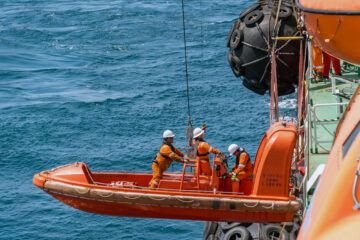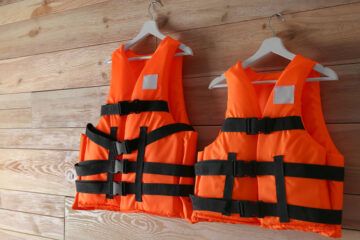Crane accidents take a heavy and tragic toll each year in lives, serious injury, and/or property damage. The vast majority of crane accidents are the result of personnel error and in many cases can be avoided. Many of these incidents involve Marine Construction. From driving sheet piling for a simple bulkhead or seawall from land, piling for a dock structure or more hazardous yet, a crane mounted on a barge, working on a bridge project, cofferdam or other on-water structure.
Crane operation safety is the result of effective teamwork among operators, riggers, and crane walkers. In most accidents, a team member either performs an unsafe action or fails to perform a required safe action. In a vast majority of cases where team personnel are at fault, it is due to inattention, poor judgment, overconfidence, or haste to get the job done. The following brief writing prescribes basic crane safety procedures that every crane team member and/or operator may just want to thoroughly understand and constantly practice to avoid a potential accident.
CRANE TEAM
The crane team consists of the crane operator, rigger-in-charge, crane riggers, and crane walkers, as required. The rigger supervisor shall designate the rigger-in-charge (team leader), crane riggers, and crane walkers. The size of the team will vary to suit the job as determined by the rigger supervisor. The concept of effective teamwork shall be stressed by management. Team members shall work together to ensure the safety of crane operations. While each member of the team has defined responsibilities, everyone is responsible for recognizing potential problems and making all team members aware of them. Any crane team member shall stop the job any time unsafe conditions are found and report to supervision problems that cannot be resolved by the team.
RESPONSIBILITIES
Rigger-in-Charge
The rigger-in-charge has overall control of the operation including: planning all aspects of the lift; determining the weight of the load to be lifted; establishing the appropriate method of communication with the operator; ensuring the load is properly rigged; ensuring the crane operating envelope remains clear of all obstructions; providing signals to the operator or assigning another rigger or signal person to provide the signals; and conducting the operation in a safe manner. The rigger-in-charge shall coordinate the activities of other crane team members.
Crane Rigger
The crane rigger is responsible for carrying out the assignments from the rigger-in-charge or the rigger supervisor, including: assisting the crane operator in performing his pre-use check of the crane; proper gear selection and inspection prior to use; safe rigging of the load; and keeping the rigger-in-charge informed of questionable conditions associated with the operation.
Crane Walker
Crane walker responsibilities include: assisting the rigger and operator in the pre-use check of the crane; and ensuring the safe travel of the crane by observing for potential obstructions, properly aligning crane rail switches, and being in a position to immediately notify the operator to stop operations should a potential problem arise.
Operator Responsibilities
The primary responsibility of the operator is the safe operation of the crane. Operator responsibilities include: performing a preuse check of the crane at the start of the shift; fully understanding the lift prior to starting, including participating in pre-lift briefings; maintaining communication with the rigger-in-charge or designated rigger throughout the operation; making movements only when given the direction to do so (when such direction is required, e.g., for cab operated cranes); and refusing to operate the crane when there are concerns about the safety of the operation. First and perhaps most important, the operator shall, by selfexamination, determine whether he/she is physically, mentally and emotionally fit to operate the machine. The lives of many may be dependent on the operator’s actions. If the operator is on medication, he/she shall consult a physician regarding adverse effects. The
operator shall ask him/herself daily:
Do I feel well?
Can I handle the physical tasks of operating?
Do I have a clear head and am I thinking and remembering properly?
Am I alert?
Is my attitude good today?
Am I calm, cool, and collected?
If an operator cannot honestly answer yes to these questions, operating a crane could be
an accident hazard and he/she shall not operate the crane.
UNDERSTANDING THE CRANE
Generally, crane operators at naval activities are required to operate various types, makes, and models of cranes. The operator shall be thoroughly familiar with the operating characteristics,
including posted operational restrictions or limitations, of each type, make, and model of crane that may be operated.
SAFETY DEVICES
There are many varieties of cranes and safety devices on them. Many safety systems are complex and require thorough training on their operations. This is particularly so on mobile cranes that are often leased or rented for short term use. Activities shall ensure, through training, pre-briefs, spot checks, or performance examination, that operators and supervisors are knowledgeable of the operation of safety systems on assigned cranes. It cannot be presumed that knowledge of a system on one crane indicates adequate knowledge on other cranes. Operators shall fully understand that safety devices such asinterlocks and limit switches shall not be used as operational controls. They are not a substitute for full attention by the operator to potential hazards.
Operators shall be trained to approach limit switches (hoist, rotate, and travel) only at slow speed. Additionally, each activity shall develop procedures for controlling the bypassing of safety devices. Supervisors shall control the usage of keys for safety device bypassing. Keys shall be removed from the bypass switches when not in use. The keys shall be removed from the crane and shall be retained by the supervisor unless unique activity operations (e.g., operating mobile cranes at remote sites) require that the keys remain. Where this is not practical or where safety devices may be bypassed by other means, permission for bypassing/defeating safety devices (except for performance of the operator’s pre-operation inspection) shall be obtained from the operator supervisor. This requirement shall be posted in the operator’s cab.
For mobile and electric cranes that do not provide protection against two-blocking, activities shall develop crane specific procedures designed to minimize the possibility of two-blocking (e.g., prohibiting hoisting when hook block is within 10 feet of contacting the boom or 3 feet from contacting the hoist frame, providing a rigger to watch the hook block when the hook approaches the boom or hoist frame, prohibiting any simultaneous crane movement while
hoisting, etc.). Supervisors shall brief operators on the procedures prior to assignment on such cranes.
ADDITIONAL REQUIREMENTS FOR OPERATIONAL SAFETY DEVICES, GENERAL SAFETY DEVICES, AND OPERATIONAL AIDS FOR CRANES USED IN CONSTRUCTION
The following operational safety devices, general safety devices, and related equipment are required on cranes used in construction operations, unless otherwise specified:
a.) A properly working crane level indicator that is either built into the equipment or is available on the equipment. This requirement does not apply to portal cranes, derricks, floating cranes/derricks and land cranes/derricks on barges, pontoons, vessels or other means of flotation;
b.) Boom stops, except for derricks and hydraulic booms;
c.) Jib stops (if a jib is attached);
d.) Equipment with foot pedal brakes shall have locks on the pedals;
e.) Hydraulic outrigger jacks and hydraulic stabilizer jacks shall have an integral holding device/check valve
f.) Hydraulic boom luffing and telescoping cylinders shall have an integral holding device; and
g.) For equipment manufactured after December 16, 1969, a boom hoist limiting device is required. If the equipment was manufactured on or before December 16, 1969, and is not equipped with a boom hoist limiting device, at least one of the following alternative measures is required;
i. Use a boom angle indicator.
ii. Clearly mark the boom hoist cable (so that it can easily be seen by the operator) at a point that will give the operator sufficient time to stop the hoist to keep the boom within the minimum allowable radius. In addition, install mirrors or remote video cameras and displays if necessary for the operator to see the mark.
iii. Clearly mark the boom hoist cable (so that it can easily be seen by a spotter) at a point that will give the spotter sufficient time to signal the operator and have the operator stop the hoist to keep the boom within the minimum allowable radius.
h.) Luffing jib limiting device (for cranes with luffing jibs);
i.) Telescopic boom cranes manufactured after February 28, 1992, shall be equipped with anti two-block or two-block damage prevention device(s). The device(s) shall prevent such damage at all points where two-blocking could occur;
j.) Lattice boom cranes manufactured after February 28, 1992, shall be equipped with anti two-block or two-block damage prevention device(s), or warns the operator in time for the operator to prevent two-blocking. The device shall prevent such damage/failure or provide adequate warning for all points where two-blocking could occur;
k.) Articulating boom cranes manufactured after December 31, 1999 equipped with a load hoist shall be equipped with anti twoblock or two-block damage prevention device(s). The device(s) shall prevent such damage at all points where two-blocking could occur;
l.) Boom angle or radius indicator readable from the operator’s station (not required for articulating boom cranes);
m.) m. Jib angle indicator if the equipment has a luffing jib (not required for articulating boom cranes);
n.) n. Boom length indicator if the equipment has a telescopic boom, except where the rated capacity is independent of the boom length (not required for articulating boom cranes);
o.) o. Equipment manufactured after March 29, 2003 shall have at least one of the following: load weighing device, load moment (or rated capacity) indicator, or load moment (or rated capacity) limiter;
p.) p. Category 2 or 3 cranes (Trolley, Overhead Hoists, Bridge Cranes, etc.) used in construction shall have an anti-two block device;
q.) q. A properly working horn that is either built into the equipment or is on the equipment and immediately available to the operator; r.) r. Cranes on rails shall have rail clamps and rail stops, except for portal cranes; and
s.) s. An accessible fire extinguisher shall be provided on the crane.
t.) Operations shall not begin unless all of the devices noted above are in proper working order. If a device stops working properly during operation, removed from service and operation shall
not resume until the device is working properly.
OEM’S OPERATION MANUAL
Crane operators shall read, thoroughly understand, and comply with all procedures, safety instructions, and precautions in the OEM’s operation manual. This also applies to instructors and supervisors in initial checkout of new cranes.
Where operating procedures are unavailable from the manufacturer, the activity shall develop and ensure compliance with all procedures necessary for the safe operation of the equipment
and attachments. Procedures that change or develop the capacity of the crane (where the original capacity is not available from the manufacturer) shall be submitted to the
Owner/Project Manager for approval.
The OEM’s operation manual shall be on the crane and readily available to the operator for all types of cranes. Where instructions provided by the OEM are in conflict with local safety instructions or safety procedures provided in this document, the operator shall refer such conflicts to his supervisor for resolution.
OEM’S SUPPLEMENTAL SAFETY INFORMATION
Manufacturers, particularly of mobile cranes, often issue information more current and supplemental to that in the operation manual furnished with a particular crane. Much of the information (although sometimes addressed in service bulletins) pertains to the safe operation of the crane. Activities shall contact the OEM or authorized distributor for supplemental information applicable to their cranes, and, if practical, be added to the OEM’s distribution list
for such information.
LIFTING OPERATIONS
Lifting operations shall be classified into two basic categories: complex lifts and non-complex lifts. Except as noted, lifts of ammunition and explosives (ordnance) are considered to be a category separate from these criteria for complex/non-complex lifts. Ordnance lifts have unique procedures and approved ordnance handling equipment that must be utilized. However, lifts of ordnance involving the use of tilt fixtures; lifts of ordnance onto/from barges, bridge decks, piers and the like where binding may occur and lifts of ordnance should be treated as complex lifts. A pre-lift brief shall be conducted to ensure the roles and responsibilities of the crane team and the ordnance handling team are understood and fully coordinated. For ordnance lifts, the ordnance handling team leader has the overall responsibility for the safety of the lift.
Complex Lifts
These are lifts with a moderate to high level of risk involving:
a. Hazardous materials, e.g., poisons, corrosives, highly volatile substances, etc. This does not include palletized unit loads of ordnance, nor materials such as oxygen, acetylene, propane, diesel fuel, or gasoline in cans, or tanks that are properly secured in racks or stands designed for lifting and transporting by crane.
b. Large and complex geometric shapes.
c. Lifts of personnel.
d. Lifts exceeding 80 percent of the capacity of the crane’s hoist (e.g., main hoist, whip hoist) planned for use (lifts exceeding 50 percent of the hoist capacity for a mobile crane mounted on a barge). For variable rated cranes, this shall be at the maximum anticipated radius planned for use.
e. Lifts of submerged or partially submerged objects.
The following lifts are not considered complex:
a. Removal of valves, rotors, pipes, etc., from dip tanks for cleaning or coating purposes. Lifting boats of known weight from the water if the boats are of open design with bilge compartments accessible for visual inspection; the boats have label plates indicating weights; and the boats have pre-determined lifting points established by the OEM or the activity engineering organization.
b. Lifting submerged or partial submerged objects that meet the
following criteria:
(i) the object is verified to not contain fluid in pockets and/or voids that is unaccounted for in the weight of the object;
(ii) the object is verified or known to not be stuck by suction or adhesion by corrosion, marine growth, excessive surface tension, mud, etc.;
(iii) and the object is verified to be clear of obstructions such as other objects in the water, underwater cables, etc.;
c. Multiple crane or multiple hook lifts on the same crane, except for bridge or gantry cranes with hooks coupled together and specifically designed for simultaneous lifting such as jet engine test stand lifting cranes.
d. Lifts of unusually expensive or one-of-a-kind equipment or components.
e. Lifts of constrained or potentially constrained loads (binding condition).
f. Other lifts involving non-routine operations, difficult operations, sensitive equipment, or unusual safety risks. Identification and Procedures Activities shall identify complex lifts and prepare procedures (including rigging sketches where required) for conducting these lifts. Procedures may be standard written instructions or detailed procedures specific to a lift.
Supervisor or Working Leader Review and Oversight
A rigger supervisor, operator supervisor, or a rigging or crane operator working leader (classified as WL) shall review on-site conditions for complex lifts and shall perform a pre-job briefing before each complex lift to ensure all crane team personnel understand the required procedures for the lift. For lifts of ordnance, this brief is in addition to the brief conducted by the ordnance handling team leader as required. A rigger supervisor, operator supervisor, or working leader shall personally supervise the following lifts:
a. Lifts exceeding 80 percent of the certified capacity of the crane’s hoist used for the lift;
b. Multiple hook lifts when the weight of the object being lifted exceeds 80 percent of the certified capacity of any hoist used for the lift; and
c. Lifts of ordnance involving the use of tilt fixtures. If the lifts are
repetitive in nature, the supervisor or working leader shall be present during the first evolution of the lift with each rigging crew. Subsequent identical lifts by the same crew may be done under the guidance of the rigger-in-charge.
Non-Complex Lifts
These lifts are ordinary in nature and do not require supervisory oversight. They may be made at the discretion of a qualified rigger.
Pre-lift Preparation
Operators and riggers shall understand and comply with the load rating chart posted on the crane. The rigger giving the signals shall be identified and the type(s) of communication to be used shall be established.
To avoid overloading any equipment (e.g., hoist, rigging gear, container, material handling platform) used in a crane lift, the riggerin-charge shall know or have a reasonable estimate of the weight to be lifted and, if applicable, the maximum radii at which the load will be picked and positioned. If the weight is estimated to exceed 50 percent of the capacity of the hoist (at the maximum anticipated radius if applicable) or 80 percent of the capacity of the rigging gear,
platform/skid, below-the-hook lifting device, etc., the weight shall be verified by performing an engineering evaluation or using a local procedure approved by the certifying official or activity engineering organization.
Alternatively, a load indicating device shall be used. Where overloading of the crane or rigging is possible due to binding conditions, a portable load indicating device with a readout readily
visible to the signal person or rigger-in-charge shall be used. When a load indicating device is used, an appropriate stop point shall be established and the load indicating device shall be carefully monitored to ensure the stop point is not exceeded. When necessary, chain-falls
or other hoisting control means shall be used to avoid sudden overload of the crane or rigging gear. This is a complex lift.
The operator shall know the boom and jib length and crane configuration, and thoroughly understand and comply with the crane’s load rating charts and accompanying notes. When determining the safe maximum working radius for the load to be handled, the crane team shall consider whether the lift will be made over the side, front, or rear (or any combination), and whether operation will be on tires or outriggers/stabilizers. For lifts exceeding 50 percent of the crane’s capacity at the maximum anticipated radius planned for use, verify by actual measurement or by operating the crane with an empty hook through the lift evolution and verifying the radii from the radius indicator. For lifts exceeding 80 percent, verify by actual measurement where possible (i.e., do not rely solely on the crane radius indicator).
Ideally, the crane should be positioned equidistant between the pickup and set down points. This will limit the need for changing boom positions. Verify that the load to be lifted is within the crane’s allowable loading (including appropriate deductions for hook, block, ancillary
equipment, etc.) for all measured radii. Do not exceed these distances during the actual lift. If a load cannot be placed where originally intended, verify the radius (and allowable load) of the new set down location prior to landing the load. Periodically, the operator shall compare known weights and measured radii against load and radius indicating devices on the crane to verify the accuracy of the devices. If accuracy is questionable, notify the supervisor.
EQUIPMENT WEIGHTS AND MARKING
Man lifts, aerial platform vehicles, forklifts, mobile cranes, and similar equipment that may be lifted by crane shall be weighed and stenciled with the weight in pounds. For activities located in foreign countries, additional marking of the weights in kilograms is acceptable. OEM marked weights are acceptable. Lifting points and/or lifting configurations shall be identified. Sand
hoppers, tubs, platforms, custom designed skids and pallets, and bother large containers that may contain material shall be marked with empty and full weights. For containers utilized for trash or scrap, the safe working load may be marked, provided the container is open or
accessible to allow the rigger to determine the type and weight of the material placed in the container. Full weights shall be established by the OEM or the activity engineering organization.
If the container’s weight is not marked, its weight shall be verified by the use of a load indicating device or dynamometer. The load indicating device, dynamometer, rigging gear, and crane shall be sized to pick up the maximum possible weight of the unmarked load. If a marked
container cannot be physically verified as empty or the container is only marked with a full weight, the container shall be considered full or a load indicating device shall be used.
GROUND CONDITIONS
Cranes shall not be operated or assembled/disassembled unless ground conditions are firm, drained, and graded to a sufficient extent so that, in conjunction with the use of supporting materials (if necessary), the crane manufacturer’s specifications for adequate support and degree of level of the crane are met. The activity shall ensure the operator is aware of the location of know crane set-up area, such as voids, tanks, and utilities. If the operator determines that ground conditions are unsatisfactory or questionable, work shall not proceed and the activity engineering organization shall be notified for evaluation.
COMMUNICATIONS
Operators and riggers shall understand and use the Standard “Crane Hand Signals” for controlling crane operations. Additional signals (if required) shall be approved by operator and
rigger supervisors and shall be included in operator and rigger training programs. All hand signals shall be posted in the crane cab in view of the operator. If pickup and lay down areas are not readily accessible by a single rigger, additional riggers shall be assigned as necessary.
A positive means of transferring control of the load between riggers shall be used. Direct voice and radio communications are also acceptable.









